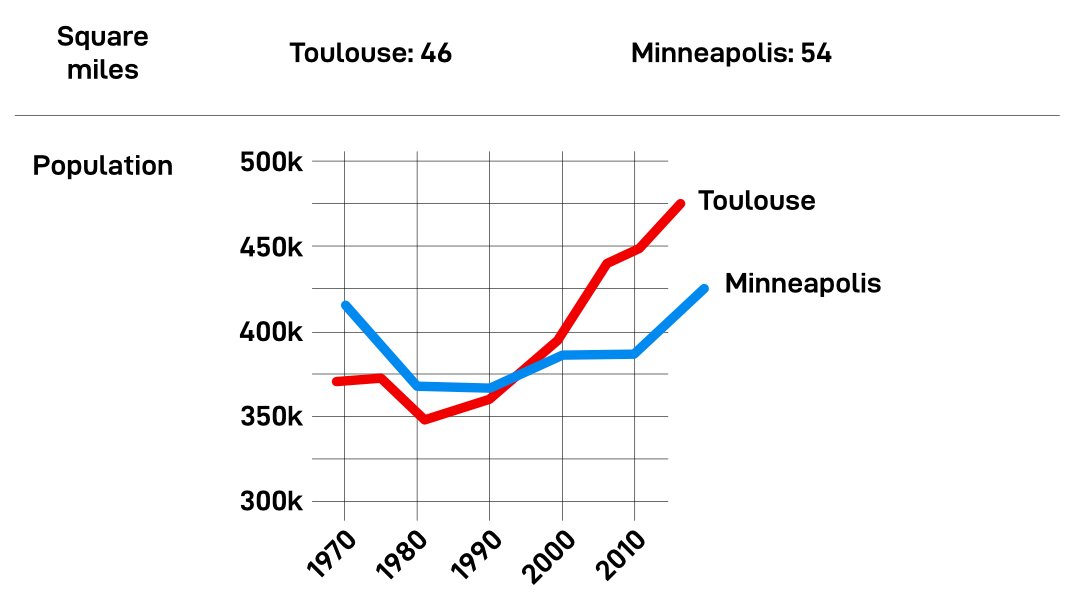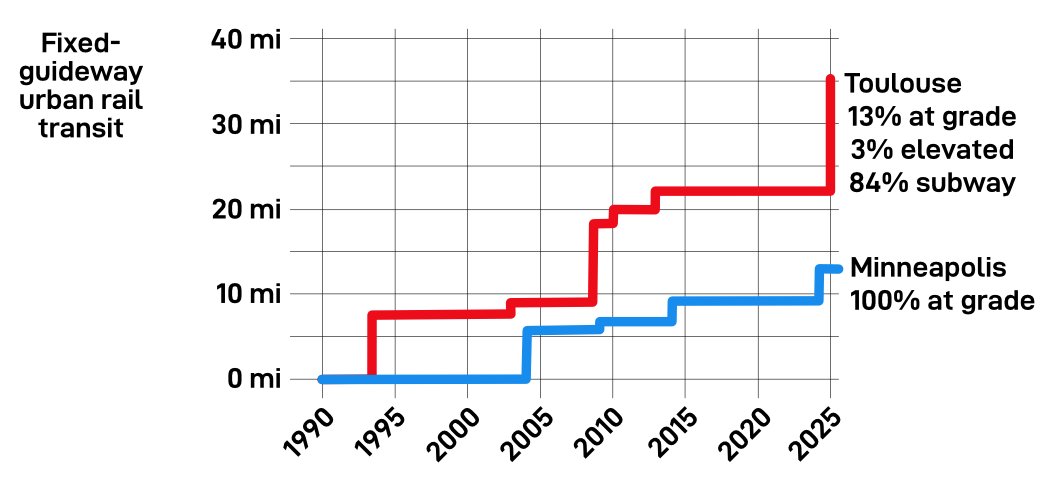Toulouse FR & Minneapolis MN are similar in terms of land area.
In 1970, they had the same population density:
- Toulouse: ~8100 ppl/sq mile
- Minneapolis: ~8050 ppl/sq mile
Since then, Toulouse has densified considerably. Minneapolis has increased in population, but not much.
In 1970, they had the same population density:
- Toulouse: ~8100 ppl/sq mile
- Minneapolis: ~8050 ppl/sq mile
Since then, Toulouse has densified considerably. Minneapolis has increased in population, but not much.
Since 1990, they& #39;ve each invested in rail transit expansion. Toulouse has built metros and a tramway line; Minneapolis several light rail links.
*Within* the two cities, Toulouse has built 22 miles of such projects, >80% in subway.
Minneapolis has built 9.4 miles, all at grade.
*Within* the two cities, Toulouse has built 22 miles of such projects, >80% in subway.
Minneapolis has built 9.4 miles, all at grade.
By 2025, Toulouse will have >35 miles of urban rail transit within the city itself. Almost all of that will be in subway.
By 2025, Minneapolis will have about 13 miles, all of that at grade, running at the street level.
By 2025, Minneapolis will have about 13 miles, all of that at grade, running at the street level.
These are two very different cities, and Minneapolis is in a much larger metropolitan area than Toulouse.
They& #39;re indicative of the varying approaches US & French cities have taken to population and transportation development.
They& #39;re indicative of the varying approaches US & French cities have taken to population and transportation development.
US cities have invested far less in transit expansion. When they& #39;ve done so, it& #39;s been at a lower quality. Toulouse& #39;s systems are mostly grade separated—meaning they& #39;re fast and reliable. Light rail is better than bus service, but can be considerably delayed and is much slower.
US cities have also suffered far more from population loss and lack of densification. Toulouse& #39;s population density has increased by 28% since 1970; Minneapolis& #39; has increased by only 2%.
The result is less vital, less active cities.
The result is less vital, less active cities.
US cities thus not only don& #39;t have the tax base of their French counterparts, they& #39;re also more heavily reliant on cars.
In Minneapolis, about 21% of people take transit or walk to work (and that& #39;s really high for the US!).
In Toulouse, the equivalent number is 34%.
In Minneapolis, about 21% of people take transit or walk to work (and that& #39;s really high for the US!).
In Toulouse, the equivalent number is 34%.
Why have US cities invested so little and seen such little population growth? A few reasons:
– Continuous exurban sprawl
- Cheap gas prices
- Zoning that dissuades densification
- Anti-black prejudice
- Massive highway expansions
- High transit construction costs
– Continuous exurban sprawl
- Cheap gas prices
- Zoning that dissuades densification
- Anti-black prejudice
- Massive highway expansions
- High transit construction costs
There& #39;s also that Minneapolis is part of a much broader region than the city. Toulouse& #39;s city share of regional population is far higher.
And while Toulouse& #39;s mayor has strong influence over transportation planning, in Minneapolis, county & metro governments make the choices.
And while Toulouse& #39;s mayor has strong influence over transportation planning, in Minneapolis, county & metro governments make the choices.
Toulouse & Minneapolis were similar back in 1970. They are both prosperous regions with job & population growth.
Minneapolis—like many US cities—could choose a path of high-quality transit investment, densification, & vibrancy, and it would succeed if it made the right choices.
Minneapolis—like many US cities—could choose a path of high-quality transit investment, densification, & vibrancy, and it would succeed if it made the right choices.

 Read on Twitter
Read on Twitter



